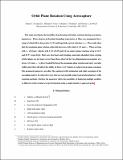Orbit Plane Rotation Using Aerocapture
Author(s)
Gochenaur, Daniel C.; Jones, Michael P.; Norheim, Johannes J.; de Weck, Olivier L.
DownloadGochenaur_JSR_AerocapturePlaneChange_Final.pdf (9.585Mb)
Open Access Policy
Open Access Policy
Creative Commons Attribution-Noncommercial-Share Alike
Terms of use
Metadata
Show full item recordAbstract
This study investigates the feasibility of performing orbit plane rotations during aerocapture maneuvers. Three-degrees-of-freedom bounding trajectories at Mars are propagated for a range of vehicle lift-to-drag ratios 𝐿/𝐷
and hyperbolic arrival velocities 𝑣∞
. The results show that the maximum plane rotation achievable increases with vehicle 𝐿/𝐷
and 𝑣∞
. When arriving with 𝑣∞
of 6 km/s, vehicles with 𝐿/𝐷
of 0.25 and 1.0 can achieve plane rotations of up to 11.6 and 45.3 deg, respectively. Heat rate, heat load, and g-loading constraints identified when rotating the orbital plane are not more severe than those observed for two-dimensional aerocapture at a given 𝐿/𝐷
and 𝑣∞
. A direct tradeoff between the maximum plane rotation and entry corridor width exists that will affect the ability of lower 𝐿/𝐷
vehicles to achieve large plane rotations. The proposed maneuver can allow the captured orbit inclination and right ascension of the ascending node to be altered in ways that are not possible using typical interplanetary orbit targeting methods. Further, the maneuver offers the possibility of deploying multiple satellites to different orbits around a target destination using a single launch or approach path.
Date issued
2025-02-13Department
Massachusetts Institute of Technology. Department of Aeronautics and AstronauticsJournal
Journal of Spacecraft and Rockets
Publisher
American Institute of Aeronautics and Astronautics
Citation
Orbit Plane Rotation Using Aerocapture
Daniel C. Gochenaur, Michael P. Jones, Johannes J. Norheim, and Olivier L. de Weck
Journal of Spacecraft and Rockets 0 0:0, 1-34
Version: Author's final manuscript
ISSN
0022-4650
1533-6794